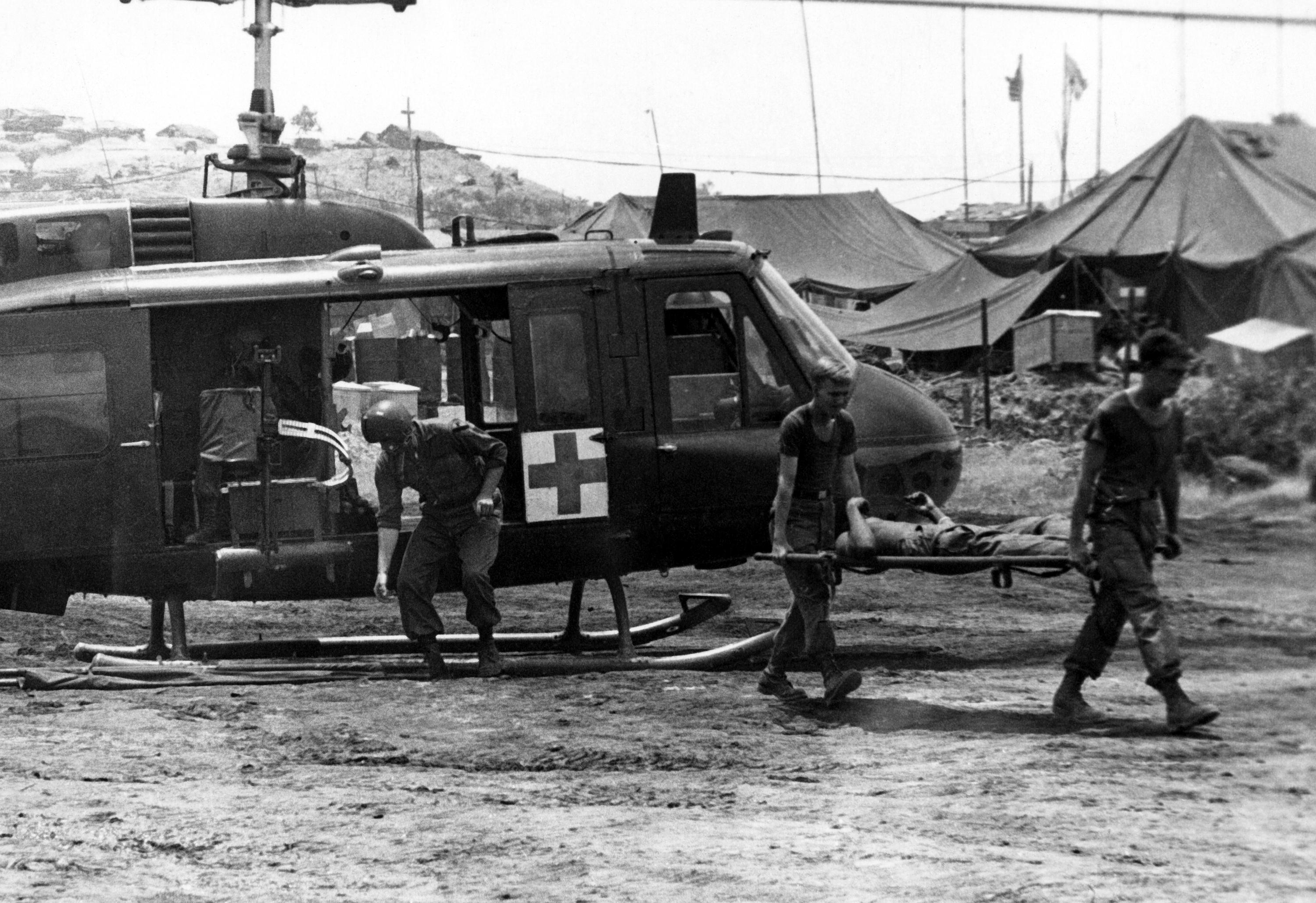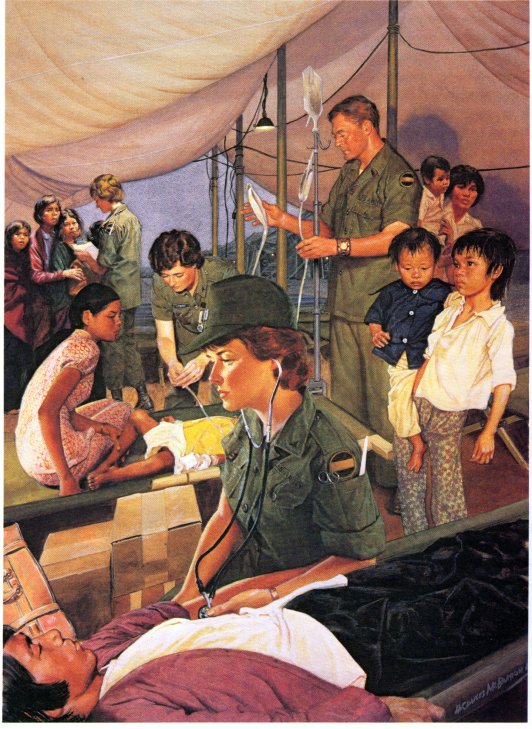Highlights in the History of the Army Nurse Corps, 1960 to 1990
Army nursing in Vietnam
actually began in April 1956 when three members arrived in
Saigon, sent by the Army to train South Vietnamese nurses about the latest
procedures and techniques. A few years later, hostilities in the Republic of Vietnam set the tone for the
1960s as the Army responded to the needs of that nation.
 Trauma care specialization as well as shock/trauma units
developed from this experience. Nursing care reflected this increased
sophistication. Continued progress in medical evacuation made
Trauma care specialization as well as shock/trauma units
developed from this experience. Nursing care reflected this increased
sophistication. Continued progress in medical evacuation made  intensive care
nursing the standard rather than the exception. Evacuation by helicopter
brought wounded military personnel to medical units within minutes
of flying time. This not only transported patients from the battle locations fifty
percent faster than in the Korea conflict, but also provided triage and
resuscitative services for casualties. During the eleven-year period between
March 1962 and March 1973, peak nurse corps strength in South Vietnam reached over nine
hundred officers in 1969. It is estimated that approximately five thousand
served in Vietnam.
intensive care
nursing the standard rather than the exception. Evacuation by helicopter
brought wounded military personnel to medical units within minutes
of flying time. This not only transported patients from the battle locations fifty
percent faster than in the Korea conflict, but also provided triage and
resuscitative services for casualties. During the eleven-year period between
March 1962 and March 1973, peak nurse corps strength in South Vietnam reached over nine
hundred officers in 1969. It is estimated that approximately five thousand
served in Vietnam.
 The progressive nature of the buildup in Vietnam placed
unique demands on the Army Nurse Corps. To meet requirements there and throughout the
world, several recruitment strategies were authorized. A short-lived Warrant
Officer Program and a short-term draft of male nurses were implemented. Both
were unpopular and failed to access the required numbers. In the end, the Army
Student Nurse Program and the Walter Reed Institute of Nursing educated the
desired number of personnel, who were obligated to serve on active duty for a
period of time.
The progressive nature of the buildup in Vietnam placed
unique demands on the Army Nurse Corps. To meet requirements there and throughout the
world, several recruitment strategies were authorized. A short-lived Warrant
Officer Program and a short-term draft of male nurses were implemented. Both
were unpopular and failed to access the required numbers. In the end, the Army
Student Nurse Program and the Walter Reed Institute of Nursing educated the
desired number of personnel, who were obligated to serve on active duty for a
period of time.
The Army Nurse Corps emerged from its Vietnam experience
with a renewed drive to meet and exceed the challenges of a growing profession.
These officers worked in a team capacity with the doctors and corpsmen that was
unmatched in civilian hospitals.
Professional inservice educational programs for advanced
training in clinical specialties, advanced staff courses, postgraduate
programs and long-term civilian education at the bachelor’s, master’s and
doctorate levels were available at Army expense. The organization enhanced
quality of care through clinical specialization and expanded nursing roles.
Courses ranging from 16 weeks to 2 years in length, educated eight categories
of nursing specialists. By 1976, in concert with the ANA’s position regarding
entry into practice, all newly commissioned officers on active duty were
required to possess a baccalaureate degree.
 During this time, army nurses supported several humanitarian missions, which included the following: in 1961, members cared for crash victims of
During this time, army nurses supported several humanitarian missions, which included the following: in 1961, members cared for crash victims of  United Airlines Flight 759 near Denver; in 1962 and in 1963, ANC
officers were airlifted to Iran and to Yugoslavia, respectively, to aid
earthquake victims; in 1964,members aided victims of a violent earthquake in
Alaska; in 1965, the healthcare professionals responded to the Dominican
Republic Crisis; in 1970, after an insurrection in Jordan, male Army nurses
participated in relief operations; in 1975, army nurses assisted Vietnamese refugees
movement to the US; in 1976, members cared for Cuban refugees; in 1982, these
officers accompanied the first contingent of U.S. troops to the Sinai; and in
1989, they supported relief efforts in the Virgin Islands following Hurricane
Hugo.
United Airlines Flight 759 near Denver; in 1962 and in 1963, ANC
officers were airlifted to Iran and to Yugoslavia, respectively, to aid
earthquake victims; in 1964,members aided victims of a violent earthquake in
Alaska; in 1965, the healthcare professionals responded to the Dominican
Republic Crisis; in 1970, after an insurrection in Jordan, male Army nurses
participated in relief operations; in 1975, army nurses assisted Vietnamese refugees
movement to the US; in 1976, members cared for Cuban refugees; in 1982, these
officers accompanied the first contingent of U.S. troops to the Sinai; and in
1989, they supported relief efforts in the Virgin Islands following Hurricane
Hugo.
Photos
|
Left from top:
Triage in a Vietnam MUST unit
1st Lt. Dorothy Williams (Rt.) and Capt. Doris Fry with the
8th Evacuation Hospital in Qazvin, Iran, 1963
|
Right from top:
"Dustoff" aeromedical evacuation flight patient is unloaded
Walter Reed Institute of Nursing students with instructor
A painting of Army nurses caring for refugee patients in
Guam during Operation New Life in 1975
|
Text by ANCA Historian COL (Ret.) C. J. Moore; Photos courtesy of the Army Medical Department Center of History and Heritage